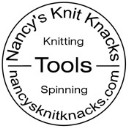NKK Yarn Meter
Product Info > Meters/Counters
Nancy's Knit Knacks is pleased to announce the introduction of the Generation II Yarn Meter
Our new Yarn Meter has a built-in tensioner. This allows the user to add the correct level of tension on their yarn to ensure that the meter works properly. This new unit can also be used to tension yarn in any application. It does not need to be used with the meter (simply remove the meter).
Our yarn meter is useful whenever you want to measure the length of yarn, string, or other material.
Accuracy - the meter measures the length in FEET. It does not measure in Yards, You simply divide the number displayed by 3 to arrive at the number of yards that have been measured.
The meter is a Fishing Meter and is used by fishermen to measure how far and/or how deep they have cast their line during fishing. It is not a commercial meter and its accuracy is less than 100%. If you need a meter that is extremely accurate, then look at our Electronic Yarn Meter which has been built from the ground up by NKK. It measures in meters and yards (as well as weight).
Our Yarn Meter, however, fills a need to enable knitters to measure the length of their yarn.
This new generation 2 version increases the accuracy and reliability quite substantially by means of the onboard yarn tensioner. Prior to this development, the user had to run the yarn through their hand to apply back tension to the yarn prior to entering the meter. Or the user could use our Yarn Meter Plus which had an array of tensioning dowels. This new variable adjusting meter, however, replaces the Yarn Meter Plus as well as the standard meter.
________________________________________
Are you having problems in using the Yarn Meter?
The secret to using the yarn meter is TENSION. You need to add the right amount of continuous tension on both sides of the meter in order to ensure an accurate measurement.
We have diagnosed most all of the possible glitches that can occur when using the yarn meter and offer the following Do's and DON'T to our users.
Ideal setup
- Yarn meter attached to table.
- Ball winder positioned about 10-16" from the meter.
- The yarn guide on the ball winder turned sideways and aimed toward the meter.
- The swift should be inline with meter as much as possible*.
- If using a ball of yarn, position it on the floor and bring the yarn up over the table's edge and in to the meter (or better yet, mount the ball on one of our Yarn Pets™)
- You need tension on the yarn prior to it entering the meter head. Use your hand or use our onboard tensioner to increase the tension.
- This setup can be reversed if desired.
Please note that the swift and ball winder can be positioned out of alignment with the meter since the meter can accommodate various angles of incoming and outgoing yarn from its yarn guides. HOWEVER, each time you change the direction of yarn, you apply tension to it and this will cause the ball to wind tighter and will produce more drag on the yarn making it more difficult to wind. THEREFORE, try to keep these devices in as straight a line as possible.
Be sure that the yarn is turning the number wheels when it is pulled through. If it isn't, then the yarn is either not inserted properly into the slot on the meter OR the meter is defective**
Don'ts
- Do not pull the yarn through by hand. Use a ball winder. The ball winder provides a more continuous and steady tension on the yarn and most importantly, eliminates the stop and go of manually pulling the yarn through.
- Do not position the ball winder too close to the meter. Give the yarn a reasonable distance to exit the meter and enter the ball winder, otherwise there may be too much tension on the ball.
If the yarn ball is too tight after winding it, that could mean that one of the following problems exist:
1. Something is obstructing the yarn from flying freely through the meter to the ball winder.
2. Make sure the source of the yarn (on the swift) is not wound too tightly or has snagging problems.
3. Make sure you are not holding the yarn too tightly prior to going into the meter.
4. Make sure you are not changing the direction of the yarn too many times between the yarn source and ball winder.
5. If the ball of yarn is too tight, then reduce the tension on the meter by allowing the yarn to go thru the tensioning post in a straighter path.
Note: a Ball Winder is REQUIRED for proper use of this device
Certain yarns which are "lumpy" may not work since their lumpy sections will not pass through the meter assembly properly. Wide Ribbon yarns may occasionally not work properly. We have run ribbon yarns up to 1/4" wide through the meter successfully.
** - if the number wheels are not turning as you are pulling the yarn through and you are certain that the yarn is engaging the small pulley inside (take the cover off to visually check that), then it is possible that the meter is faulty. If it doesn't flip the tens or hundreds over after reaching 009 or 099 then the gears may be defective). Please contact us if that is the case.






